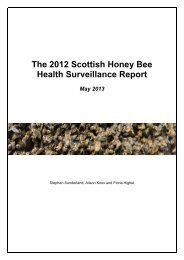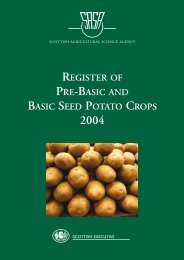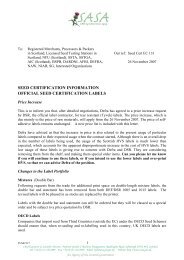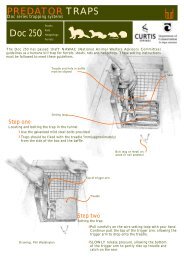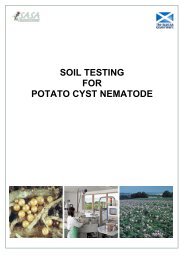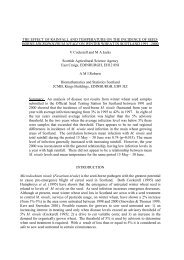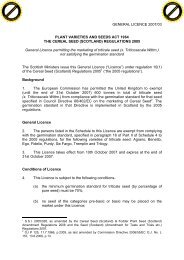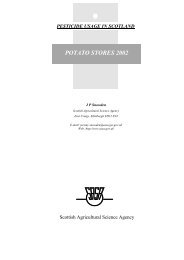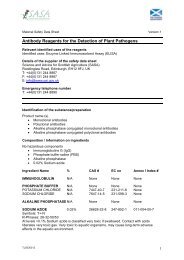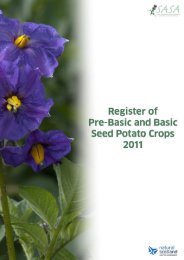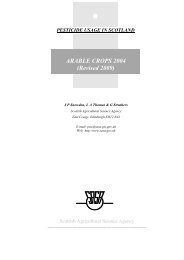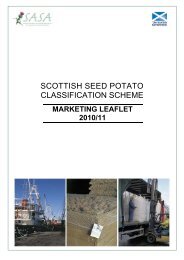Create successful ePaper yourself
Turn your PDF publications into a flip-book with our unique Google optimized e-Paper software.
Geology, Soils and Land Capability<strong>of</strong> till/drift over <strong>the</strong> lowlands <strong>of</strong> <strong>the</strong> <strong>East</strong> <strong>of</strong><strong>Scotland</strong>. The orig<strong>in</strong> <strong>of</strong> <strong>the</strong> till dependsupon <strong>the</strong> direction <strong>of</strong> movement <strong>of</strong> <strong>the</strong> icesheets and glaciers. In <strong>the</strong> South <strong>of</strong><strong>Scotland</strong>, <strong>the</strong> direction <strong>of</strong> movement waspredom<strong>in</strong>antly west to east, with <strong>the</strong> resultthat much <strong>of</strong> <strong>the</strong> till cover<strong>in</strong>g <strong>the</strong> Lothians,<strong>the</strong> Merse and <strong>the</strong> sou<strong>the</strong>rn half <strong>of</strong> Fife is<strong>of</strong> Carboniferous orig<strong>in</strong>. Fur<strong>the</strong>r north, <strong>the</strong>direction was more north to south, suchthat <strong>the</strong> till cover<strong>in</strong>g Tayside (Perth andAngus) is ma<strong>in</strong>ly <strong>of</strong> ORS orig<strong>in</strong>, as shown by<strong>the</strong> dist<strong>in</strong>ct red soils <strong>of</strong> <strong>the</strong> area. There arealso significant areas where <strong>the</strong> till iscomposed <strong>of</strong> igneous material <strong>of</strong> ORS age(e.g. N. Fife). The lowlands <strong>of</strong> Banff andAberdeenshire are covered with till fromDalradian and igneous rocks carriedeastwards. There are pronounced localdifferences; for example, <strong>the</strong> fourextensive soil associations <strong>of</strong> arableAberdeenshire are formed on tills <strong>of</strong>contrast<strong>in</strong>g chemistry (Foudland: Dalradianschist; Insch: mixed till <strong>of</strong> gabbro andschist; Tarves: mixed till <strong>of</strong> acid and basicigneous rocks; Countesswells: granite till;Table 3.1), each relat<strong>in</strong>g to <strong>the</strong> “upstream”geology. F<strong>in</strong>ally, <strong>the</strong> direction <strong>of</strong> flow <strong>in</strong> <strong>the</strong>Moray Firth area was south west to nor<strong>the</strong>ast, such that <strong>the</strong> till is made up <strong>of</strong>Mo<strong>in</strong>ian schist and granite.Two o<strong>the</strong>r aspects <strong>of</strong> <strong>the</strong> glaciation <strong>of</strong> <strong>the</strong><strong>East</strong> <strong>of</strong> <strong>Scotland</strong> are important for soilformation. First, <strong>the</strong> mass <strong>of</strong> ice wasparticularly great on <strong>the</strong> Nor<strong>the</strong>rn and<strong>East</strong>ern Highlands, with <strong>the</strong> result thatfluvioglacial processes, which washed out<strong>the</strong> f<strong>in</strong>er components <strong>of</strong> <strong>the</strong> till, were veryactive and prolonged dur<strong>in</strong>g <strong>the</strong> period <strong>of</strong>deglaciation. Thus <strong>the</strong>re are moreextensive areas <strong>of</strong> fluvioglacial sands andsandy loams <strong>in</strong> <strong>the</strong> nor<strong>the</strong>rn half <strong>of</strong> <strong>the</strong>study area, and particularly <strong>in</strong> <strong>the</strong> Laich <strong>of</strong>Moray (Corby/Boyndie Soil Association;Table 3.1), than <strong>in</strong> <strong>the</strong> sou<strong>the</strong>rn half.Secondly, <strong>the</strong> weight <strong>of</strong> ice press<strong>in</strong>g onlodgement till, has tended to compress <strong>the</strong>material, with <strong>the</strong> result that most soils,even those with relatively coarse textures,have subsoils with lower hydraulicconductivities than would be predictedfrom <strong>the</strong>ir texture.SoilsThe soil types which have formed from thisvariety <strong>of</strong> parent materials over 10,000years depend upon <strong>the</strong> <strong>in</strong>teractions <strong>of</strong>several factors:• <strong>the</strong> texture <strong>of</strong> <strong>the</strong> parent material• its base status• its hydraulic conductivity• topography• annual precipitation• vegetation (mull or mor humus)which determ<strong>in</strong>e <strong>the</strong> degree and type <strong>of</strong>leach<strong>in</strong>g and/or waterlogg<strong>in</strong>g <strong>of</strong> <strong>the</strong> soilpr<strong>of</strong>ile. These processes have producedfour major arable soil types, to which mustbe added <strong>the</strong> more recent alluvial soils(Table 3.1; Figure 3.2):Brown Forest SoilKey factors lower<strong>in</strong>g <strong>the</strong> rate <strong>of</strong> leach<strong>in</strong>g,and prevent<strong>in</strong>g podzolisation orwaterlogg<strong>in</strong>g: high <strong>in</strong>itial base status,particularly with igneous components;sandy loam to loam texture; free but notexcessive dra<strong>in</strong>age; natural vegetationbroadleaf woodland with mull humus. Moreprevalent <strong>in</strong> <strong>the</strong> sou<strong>the</strong>rn half <strong>of</strong> <strong>the</strong> studyarea. (Carpow/Panbridge; Darleith; Darvel;Hobkirk; Insch; Sourhope; Tarves)Brown Forest Soil with Gley<strong>in</strong>gKey factors: high <strong>in</strong>itial base status(particularly Carboniferous till); medium to25



